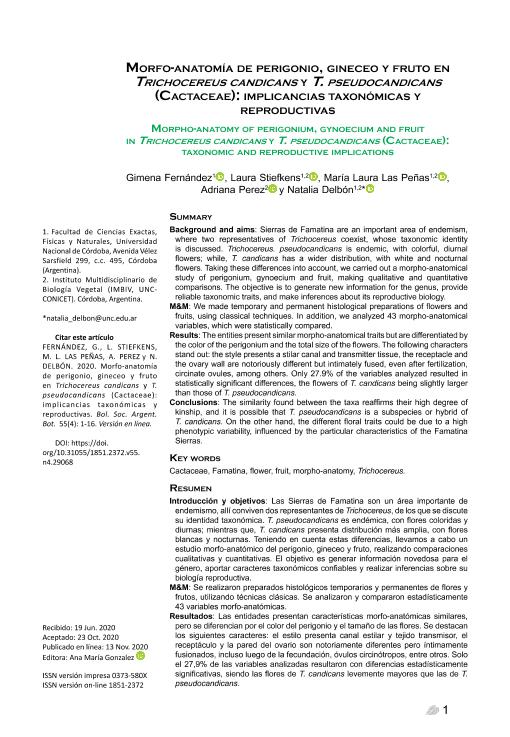Artículo
Las Sierras de Famatina son un área importante de endemismo, allí conviven dos representantes de Trichocereus, de los que se discute su identidad taxonómica. Trichocereus pseudocandicans es endémica, con flores coloridas y diurnas; mientras que, T. candicans presenta distribución más amplia, con flores blancas y nocturnas. Teniendo en cuenta estas diferencias, llevamos a cabo un estudio morfo-anatómico del perigonio, gineceo y fruto, realizando comparaciones cualitativas y cuantitativas. El objetivo es generar información novedosa para el género, aportar caracteres taxonómicos confiables y realizar inferencias sobre su biología reproductiva.M&M: Se realizaron preparados histológicos temporarios y permanentes de flores y frutos, utilizando técnicas clásicas. Se analizaron y compararon estadísticamente 43 variables morfo-anatómicas.Resultados: Las entidades presentan características morfo-anatómicas similares, pero se diferencian por el color del perigonio y el tamaño de las flores. Se destacan los siguientes caracteres: el estilo presenta canal estilar y tejido transmisor, el receptáculo y la pared del ovario son notoriamente diferentes pero íntimamente fusionados, incluso luego de la fecundación, óvulos circinótropos, entre otros. Solo el 27,9% de las variables analizadas resultaron con diferencias estadísticamente significativas, siendo las flores de T. candicans levemente mayores que las de T. pseudocandicans.Conclusiones: La similitud encontrada entre los taxones reafirma su alto grado de parentesco, siendo posible que T. pseudocandicans sea una subespecie o híbrido de T. candicans. Por otro lado, los rasgos florales diferentes podrían deberse a una alta variabilidad fenotípica, influenciada por las características particulares que presentan las Sierras de Famatina. Sierras de Famatina are an important area of endemism, where two representatives of Trichocereus coexist, whose taxonomic identity is discussed. Trichocereus. pseudocandicans is endemic, with colorful, diurnal flowers; while, T. candicans has a wider distribution, with white and nocturnal flowers. Taking these differences into account, we carried out a morpho-anatomical study of perigonium, gynoecium and fruit, making qualitative and quantitative comparisons. The objective is to generate new information for the genus, provide reliable taxonomic traits, and make inferences about its reproductive biology. M&M: We made temporary and permanent histological preparations of flowers and fruits, using classical techniques. In addition, we analyzed 43 morpho-anatomical variables, which were statistically compared. Results: The entities present similar morpho-anatomical traits but are differentiated by the color of the perigonium and the total size of the flowers. The following characters stand out: the style presents a stilar canal and transmitter tissue, the receptacle and the ovary wall are notoriously different but intimately fused, even after fertilization, circinate ovules, among others. Only 27.9% of the variables analyzed resulted in statistically significant differences, the flowers of T. candicans being slightly larger than those of T. pseudocandicans. Conclusions: The similarity found between the taxa reaffirms their high degree of kinship, and it is possible that T. pseudocandicans is a subspecies or hybrid of T. candicans. On the other hand, the different floral traits could be due to a high phenotypic variability, influenced by the particular characteristics of the Famatina Sierras.
Morfo-anatomía de perigonio, gineceo y fruto en Trichocereus candicans y T. pseudocandicans (Cactaceae): Implicancias taxonómicas y reproductivas
Título:
Morpho-anatomy of perigonium, gynoecium and fruit in Trichocereus candicans y T. pseudocandicans (Cactaceae): Taxonomic and reproductive implications
Fernandez, Gimena; Stiefkens, Laura Beatriz; Las Peñas, Maria Laura ; Perez, Adriana Nelida
; Perez, Adriana Nelida ; Delbón, Natalia
; Delbón, Natalia
 ; Perez, Adriana Nelida
; Perez, Adriana Nelida ; Delbón, Natalia
; Delbón, Natalia
Fecha de publicación:
11/2020
Editorial:
Sociedad Argentina de Botánica
Revista:
Boletín de la Sociedad Argentina de Botánica
ISSN:
0373-580X
e-ISSN:
1851-2372
Idioma:
Español
Tipo de recurso:
Artículo publicado
Clasificación temática:
Resumen
Palabras clave:
CACTACEAE
,
FAMATINA
,
MORFOANATOMIA
,
TRICHOCEREUS
Archivos asociados
Licencia
Identificadores
Colecciones
Articulos(IMBIV)
Articulos de INST.MULTIDISCIPL.DE BIOLOGIA VEGETAL (P)
Articulos de INST.MULTIDISCIPL.DE BIOLOGIA VEGETAL (P)
Citación
Fernandez, Gimena; Stiefkens, Laura Beatriz; Las Peñas, Maria Laura; Perez, Adriana Nelida; Delbón, Natalia; Morfo-anatomía de perigonio, gineceo y fruto en Trichocereus candicans y T. pseudocandicans (Cactaceae): Implicancias taxonómicas y reproductivas; Sociedad Argentina de Botánica; Boletín de la Sociedad Argentina de Botánica; 55; 4; 11-2020; 557-572
Compartir
Altmétricas



